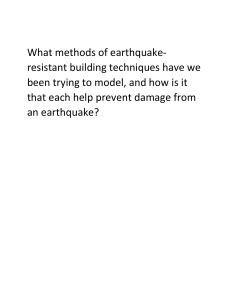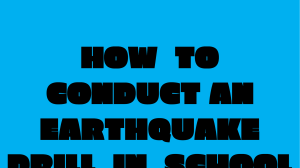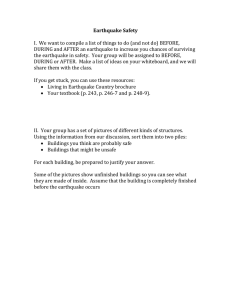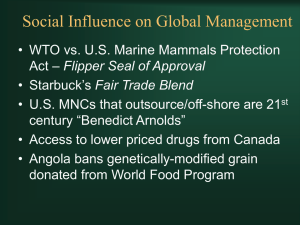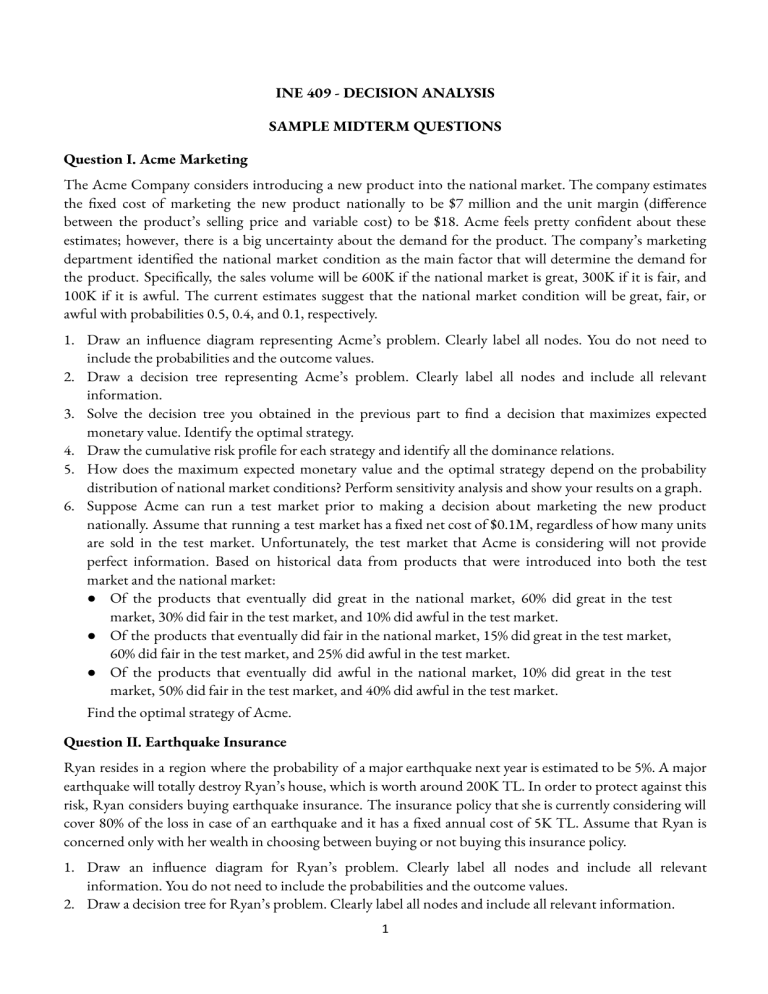
INE 409 - DECISION ANALYSIS SAMPLE MIDTERM QUESTIONS Question I. Acme Marketing The Acme Company considers introducing a new product into the national market. The company estimates the fixed cost of marketing the new product nationally to be $7 million and the unit margin (difference between the product’s selling price and variable cost) to be $18. Acme feels pretty confident about these estimates; however, there is a big uncertainty about the demand for the product. The company’s marketing department identified the national market condition as the main factor that will determine the demand for the product. Specifically, the sales volume will be 600K if the national market is great, 300K if it is fair, and 100K if it is awful. The current estimates suggest that the national market condition will be great, fair, or awful with probabilities 0.5, 0.4, and 0.1, respectively. 1. Draw an influence diagram representing Acme’s problem. Clearly label all nodes. You do not need to include the probabilities and the outcome values. 2. Draw a decision tree representing Acme’s problem. Clearly label all nodes and include all relevant information. 3. Solve the decision tree you obtained in the previous part to find a decision that maximizes expected monetary value. Identify the optimal strategy. 4. Draw the cumulative risk profile for each strategy and identify all the dominance relations. 5. How does the maximum expected monetary value and the optimal strategy depend on the probability distribution of national market conditions? Perform sensitivity analysis and show your results on a graph. 6. Suppose Acme can run a test market prior to making a decision about marketing the new product nationally. Assume that running a test market has a fixed net cost of $0.1M, regardless of how many units are sold in the test market. Unfortunately, the test market that Acme is considering will not provide perfect information. Based on historical data from products that were introduced into both the test market and the national market: ● Of the products that eventually did great in the national market, 60% did great in the test market, 30% did fair in the test market, and 10% did awful in the test market. ● Of the products that eventually did fair in the national market, 15% did great in the test market, 60% did fair in the test market, and 25% did awful in the test market. ● Of the products that eventually did awful in the national market, 10% did great in the test market, 50% did fair in the test market, and 40% did awful in the test market. Find the optimal strategy of Acme. Question II. Earthquake Insurance Ryan resides in a region where the probability of a major earthquake next year is estimated to be 5%. A major earthquake will totally destroy Ryan’s house, which is worth around 200K TL. In order to protect against this risk, Ryan considers buying earthquake insurance. The insurance policy that she is currently considering will cover 80% of the loss in case of an earthquake and it has a fixed annual cost of 5K TL. Assume that Ryan is concerned only with her wealth in choosing between buying or not buying this insurance policy. 1. Draw an influence diagram for Ryan’s problem. Clearly label all nodes and include all relevant information. You do not need to include the probabilities and the outcome values. 2. Draw a decision tree for Ryan’s problem. Clearly label all nodes and include all relevant information. 1 3. Solve the decision tree you obtained in the previous part to find a decision that maximizes expected monetary value. Identify the optimal strategy. 4. Draw the cumulative risk profile for each strategy and identify all the dominance relations. 5. How does the maximum expected monetary value and the optimal strategy depend on the probability that a major earthquake will occur? Perform sensitivity analysis and show your results on a graph. 6. Perform two-way sensitivity analysis with respect to the probability that a major earthquake will occur and the proportion of the loss that the insurance covers. Show the strategy regions on a graph. 7. Ryan comes across a company that conducts seismic analysis of the land and forecasts whether there will be a major earthquake or not next year. Past performance of the company indicates that the company forecasted a major earthquake 90% of the time when a major earthquake actually occurred and 20% of the time when a major earthquake did not occur. The company charges 1K TL to run this analysis. Draw the decision tree including the option to hire the company. Identify all possible strategies of Ryan and find the optimal strategy. Question III. Bidding for Contract A manufacturing company considers bidding for a contract to produce 100,000 units of a certain product. The company can place a bid of $5.25 per unit or a bid of $5.50 per unit. They estimate that a bid of $5.25 has a 70% chance of being accepted whereas a bid of $5.50 has a 50% chance of being accepted. If the company’s bid is accepted, then the company will have to choose between two processes available for manufacturing this product: Process A that costs $4.75 per unit and the new Process B that can cost $4, $5, or $6 per unit with equal probability. 1. Draw an influence diagram representing the company’s problem. Clearly label all nodes. You do not need to include the probabilities and the outcome values. 2. Draw a decision tree representing the company’s problem. Clearly label all nodes and include all relevant information 3. Draw the cumulative risk profiles for the following two strategies separately: (S1) Bid $5.25 and use Process B, (S2) Bid $5.50 and use Process B. Is there any dominance relation between these two strategies? 4. Solve the decision tree you obtained to find a strategy that maximizes the expected profit of the company. Clearly state the optimal strategy and its expected profit. 5. How does the maximum expected monetary value and the optimal strategy depend on the probability that a bid of $5.50 will be accepted? Perform sensitivity analysis and show your results on a graph. 6. Suppose that the company can perform a test run before submitting the bid in order to assess the cost of Process B. However, the information provided by the test run is not perfect. The test run will have one of the two outcomes: Low or High. Based on past experience, the test outcome is low with probability 80% if the cost is $4, with probability 50% if the cost is $5, and with probability 10% if the cost is $6. The test run will cost the company $3,000. Draw the decision tree including the option to perform the test run. Identify all possible strategies of the company and find the optimal strategy. Question IV. True or False 1. All good decisions yield good outcomes. 2. Each arrow in an influence diagram represents both probabilistic relevance and sequence relation between the nodes that it connects. 3. When moving downward in a fundamental-objectives hierarchy, we ask the question ‘Why is that important?’. 2 4. For maximization purposes, a random variable 𝑋 deterministically dominates a random variable 𝑌 if the best possible value of 𝑋 is greater than the worst possible value of 𝑌. 5. If a decision maker chooses the alternative that maximizes expected monetary value between the following two alternatives, then she will receive exactly 1,800 TL. Outcome 1 Outcome 2 Alternative 1 1,000 TL 2,000 TL Alternative 2 -1,500 TL 4,000 TL Probability 0.4 0.6 6. Influence diagrams are flowcharts. 7. Outcomes from each chance node of a decision tree must be mutually exclusive, but need not be collectively exhaustive. 8. Risk profiles allow comparing alternatives with respect to their probability distributions. 9. If a positive random variable 𝑋 stochastically dominates a positive random variable 𝑌, then 𝐸(ln 𝑙𝑛 𝑋 ) ≥ 𝐸(ln 𝑙𝑛 𝑌 ). 10. If two chance events are independent, then they are mutually exclusive. 11. The absence of an arrow between two chance events in an influence diagram implies that those two chance events are independent. 12. Given any two chance events 𝐴 and 𝐵, 𝑃(𝐴) = 𝑃(𝐵)𝑃(𝐵) + 𝑃(𝐵)𝑃(𝐵). 13. In an influence diagram, an arc from a chance node to a decision node indicates that the probability distribution of the uncertain event depends on the decision. 14. All decision trees can be converted into influence diagrams. 15. A contingent strategy picks an alternative only at decision nodes that will be reached with probability 1. 16. If a decision alternative with positive (random) profit 𝑋 stochastically dominates a decision alternative with positive (random) profit 𝑌, then 𝐸(100 − 𝑋) ≤ 𝐸(100 − 𝑌). 17. In a decision tree, a chance node before a decision node indicates that the decision is made after observing the outcome of the uncertain event. 18. In a decision problem where the precise values of some parameters are unknown, setting all these parameters to their upper bounds always gives a best-case scenario. 19. The strategy graph of a decision problem with three alternatives always partitions the feasible area into three nonempty regions. 20. If 𝑃(𝐵|𝐴) = 0. 6, then 𝑃(𝐵|𝐴) = 0. 4, where 𝐵 is the complement of 𝐵. 3

